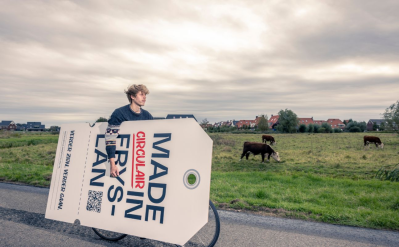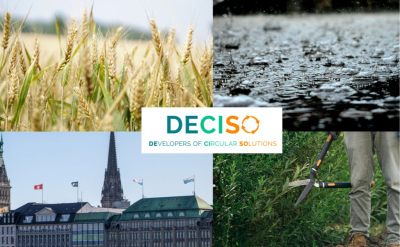News

Industrial symbiosis: many birds with one stone?
From the European Commission’s core priorities to Draghi Report, the tone is set for the next EU term: EU must enhance its competitiveness and better support its industries if it wants to ensure economic stability and prosperity. However, this cannot mean abandoning the Green Deal and its ambitious vision. A way out? Perhaps, the solution is right in front of us: industrial symbiosis offers many opportunities combining the economic renewal of the European industry with sustainability objectives. A topic we have been working on, at ACR+ trying to bring the debate closer to local and regional authorities.
Industrial symbiosis can be broadly defined as an ‘ecosystem system in which producing companies share resources, energy and waste between each other, where waste and/or by-products of one company are no longer discarded but used by another company’. Undoubtedly, this leads to material, energy and resource savings for all parties involved. But it does not stop there: these savings have positive impacts on the wider community as they can reduce GHG emissions, pollution and other adverse impacts normally associated with industrial processes.
Therefore, industrial symbiosis is an important component of circular economy, targeting the upstream actors rather than end-users and consumers. This is one of the reasons why there seems to be a common understanding that industrial symbiosis is the ‘business of the business sector'. It is often perceived as a ‘technical issue’ about the production processes protected by the competitive privacy of the manufacturers. This is particularly prominent when large industries are involved.
For the Hubs for Circularity (H4C) project, ACR+ is exploring the ways in which public authorities engage with private actors to support industrial symbiosis. During our exchanges with local and regional authorities, we often hear that it is challenging to find a role for themselves in a context largely dominated by private stakeholders. This brings up questions about governance. Is there really no place for public authorities when it comes to supporting industrial symbiosis? The experience from the ground seems to disagree: there are many initiatives which show that public authorities have a variety of tools to engage with the industrial stakeholders. These cover a vast area from the usual ‘law maker’ role to facilitation of exchange between different industries.

For the same project, ACR+ recently undertook a detailed policy analysis of the regions which have high-potential for industrial symbiosis (curious where they are? Remember to sign-up to the website not to miss it!). This meant a deep dive into the regional and national polices, funding and other support instruments targeting industrial processes. We have found that initiatives abound, and they respond to local challenges while accommodating the specificities of the territory. For instance, while in Flanders, Belgium, industrial symbiosis is considered a way of safeguarding the competitive edge of the region, in Silesia, Poland, such initiatives can be a way of addressing heavy pollution from the conventional industries.
One of the most frequent ways for public authorities to support IS is building platforms: these are spaces of exchange of information and/or materials. They help companies to connect with each other and find potential partners to build symbiotic relationships. These platforms can be in the form of directories where companies list their by-products to find an interested buyer or they can look for secondary materials to use in their production processes. Examples include Flanders’ Symbiosis Platform, French ‘Reseau Synapse’, the Circular Biz website in South of Holland and the Industrial Symbiose Noord, in Northern Denmark.
These platforms underpin a wider role for public authorities because they are important components of community and ecosystem building. This is essential as industrial symbiosis involves a diversity of actors who do not always have the ‘reflex’ of working together. Different sectors, value chains, public and private entities, ports and waste management companies, urban and rural territories can take part in these ecosystems. Public authorities can take on the coordination role, exploring diverse needs and aspirations, building bridges between these actors and finally channelling this diversity towards common goals. This coordination can be shaped as a one-stop-shop, providing advice, training as well as networking opportunities to business, as in the case of Navarra Zirkular.
More conventional interventions are also possible: public authorities are able to set the direction towards which companies will travel: circular economy action plans, waste plans, emissions standards and spatial planning rules can be used to influence their behaviour. Here the examples are landfill or emission levies, giving priority to circular business in accessing industrial parks or facilitating the materials exchange by addressing legal barriers (e.g end of waste criteria).
Providing financial support to innovative projects is another form of intervention that public authorities can rely on. In many cases, that takes the form of subsidies, tax benefits or funding programs. They can be general or targeting specific sectors, adapted to the needs of the territory. The National Growth Fund in the Netherlands will invest 220M Euros in making plastics circular between 2022-2030[1]. Some of this will be used to fund the Circular Plastics Programme (CPNL) which is aiming to address the bottlenecks to circularity in the Plastics Sector[2]. In Flanders, Moonshot program supports early and late-stage innovation projects by 2040, which in turn deliver low emission and circularity targets set for 2050[3]. In France where Resilience and Recovery Plan is used to deliver over-arching policy objectives, including decarbonisation of the industry. In Haut-de-France, RRF was used by 30 businesses under the thematic ‘ecology’ and sub-thematic ‘decarbonisation of the industry’ amounting to an investment of EUR 600M[4].
These are just some examples of the vast area of action that public authorities can explore in trying to tackle the twin challenge of sustainability and competitiveness in their territory. There are certainly new ideas to explore and a need to learn from good practices. There is also a need to better define the role of public authorities in encouraging industrial symbiosis and make sure their efforts pay off in bringing benefits for the entire community.
[1] Government of Netherlands, 2023, National Circular Economy Program, Available at: National Circular Economy Programme 2023 - 2030 | Policy paper | Rijksoverheid.nl
[4] Ministry of Economy, Finances and Industrial and Digital Sovereignty, Progress of use for the Recovery Funds for France, [In French], [Online]. Accessed: 12 June 2024. Available: Tableau de bord | economie.gouv.fr












